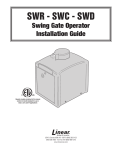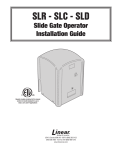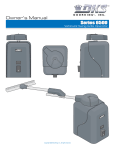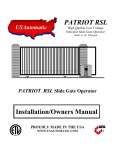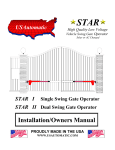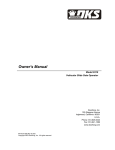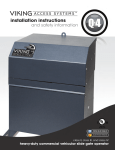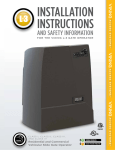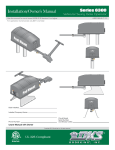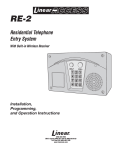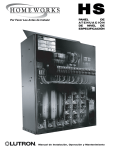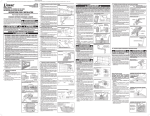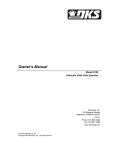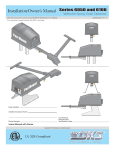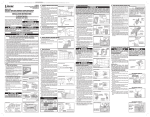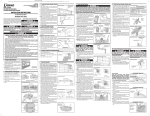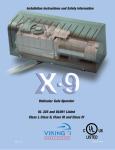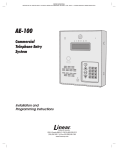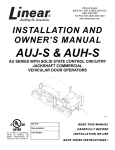Download Linear LRA User's Manual
Transcript
LRA Linear Residential Actuator Installation Guide IN T E R T E K CM C US L I ST E D Operator models contained in this manual conform to UL325 standard for use in Class I, II, III, and IV applications USA & Canada (800) 421-1587 & (800) 392-0123 (760) 438-7000 - Toll Free FAX (800) 468-1340 www.linearcorp.com Table of Contents Pre-installation Information. . . . . . . . . . . . . . . . . . . . . . . . . . . . . . . . . . 1 Before You Begin... . . . . . . . . . . . . . . . . . . . . . . . . . . . . . . . . . . . . . . 1 Always Check the Gate’s Action. . . . . . . . . . . . . . . . . . . . . . . . . . . . 1 Gate Operator Classifications. . . . . . . . . . . . . . . . . . . . . . . . . . . . . . 1 Approved Obstruction Detection Devices. . . . . . . . . . . . . . . . . . . . . 1 Safety Information and Warnings. . . . . . . . . . . . . . . . . . . . . . . . . . . . . . 1 Regulatory Warnings. . . . . . . . . . . . . . . . . . . . . . . . . . . . . . . . . . . . . 1 Linear Actuator Operator Overview. . . . . . . . . . . . . . . . . . . . . . . . . . . . 2 Wiring Specifications . . . . . . . . . . . . . . . . . . . . . . . . . . . . . . . . . . . . . . . 2 AC Power Wiring. . . . . . . . . . . . . . . . . . . . . . . . . . . . . . . . . . . . . . . . 2 DC Control and Accessory Wiring. . . . . . . . . . . . . . . . . . . . . . . . . . . 2 Control Box Mounting. . . . . . . . . . . . . . . . . . . . . . . . . . . . . . . . . . . . . . . 2 Gate Layout Illustration. . . . . . . . . . . . . . . . . . . . . . . . . . . . . . . . . . . . . .3 Mounting Bracket Installation . . . . . . . . . . . . . . . . . . . . . . . . . . . . . . . . 4 Post Bracket Installation . . . . . . . . . . . . . . . . . . . . . . . . . . . . . . . . . . 4 Gate Bracket Installation. . . . . . . . . . . . . . . . . . . . . . . . . . . . . . . . . . 4 Operator Setup . . . . . . . . . . . . . . . . . . . . . . . . . . . . . . . . . . . . . . . . . . . . 5 Operator Mounting . . . . . . . . . . . . . . . . . . . . . . . . . . . . . . . . . . . . . . 5 Controller Connection. . . . . . . . . . . . . . . . . . . . . . . . . . . . . . . . . . . . 5 AC Power Connection. . . . . . . . . . . . . . . . . . . . . . . . . . . . . . . . . . . . 5 Earth Ground. . . . . . . . . . . . . . . . . . . . . . . . . . . . . . . . . . . . . . . . . . . 5 Limit Switch Adjustment . . . . . . . . . . . . . . . . . . . . . . . . . . . . . . . . . . 6 Manual Disconnect. . . . . . . . . . . . . . . . . . . . . . . . . . . . . . . . . . . . . . 6 Controller Features. . . . . . . . . . . . . . . . . . . . . . . . . . . . . . . . . . . . . . . . . 7 Indicator Descriptions. . . . . . . . . . . . . . . . . . . . . . . . . . . . . . . . . . . . . . . 8 Terminal Descriptions. . . . . . . . . . . . . . . . . . . . . . . . . . . . . . . . . . . . . . . 9 Operator Accessory Connections. . . . . . . . . . . . . . . . . . . . . . . . . . . . 10 Basic Controller Programming. . . . . . . . . . . . . . . . . . . . . . . . . . . . . . .11 Programming Overview. . . . . . . . . . . . . . . . . . . . . . . . . . . . . . . . . . 11 Entering Programming Mode . . . . . . . . . . . . . . . . . . . . . . . . . . . . . 11 Exiting Programming Mode. . . . . . . . . . . . . . . . . . . . . . . . . . . . . . . 11 Programming Keystrokes . . . . . . . . . . . . . . . . . . . . . . . . . . . . . . . . 11 Left or Right Hand Operation. . . . . . . . . . . . . . . . . . . . . . . . . . . . . .11 Dual Gate Enable . . . . . . . . . . . . . . . . . . . . . . . . . . . . . . . . . . . . . . 11 Auto Close Timer. . . . . . . . . . . . . . . . . . . . . . . . . . . . . . . . . . . . . . . 11 Run Alarm and Pre-start Alarm. . . . . . . . . . . . . . . . . . . . . . . . . . . . 12 Maximum Open Direction Current Setting. . . . . . . . . . . . . . . . . . . . 12 Maximum Close Direction Current Setting . . . . . . . . . . . . . . . . . . . 12 Advanced Controller Programming. . . . . . . . . . . . . . . . . . . . . . . . . . . 13 Entering Advanced Programming Mode. . . . . . . . . . . . . . . . . . . . . 13 Maximum Run Time . . . . . . . . . . . . . . . . . . . . . . . . . . . . . . . . . . . . 13 Single Button Input Setup. . . . . . . . . . . . . . . . . . . . . . . . . . . . . . . . 13 Stagger Mode. . . . . . . . . . . . . . . . . . . . . . . . . . . . . . . . . . . . . . . . . 13 Stagger Delay Time. . . . . . . . . . . . . . . . . . . . . . . . . . . . . . . . . . . . . 13 Auxiliary Relay Mode. . . . . . . . . . . . . . . . . . . . . . . . . . . . . . . . . . . . 14 Reverse Delay Time . . . . . . . . . . . . . . . . . . . . . . . . . . . . . . . . . . . . 14 Low Power Mode. . . . . . . . . . . . . . . . . . . . . . . . . . . . . . . . . . . . . . . 14 Power Failure Mode. . . . . . . . . . . . . . . . . . . . . . . . . . . . . . . . . . . . . 14 Soft Start/Stop Duration . . . . . . . . . . . . . . . . . . . . . . . . . . . . . . . . . 15 Reset Cycle Count . . . . . . . . . . . . . . . . . . . . . . . . . . . . . . . . . . . . . 15 Maintenance Alert Trigger. . . . . . . . . . . . . . . . . . . . . . . . . . . . . . . . 15 Mid-travel Stop Position. . . . . . . . . . . . . . . . . . . . . . . . . . . . . . . . . . 15 Motor Type Selection. . . . . . . . . . . . . . . . . . . . . . . . . . . . . . . . . . . . 15 Radio Enable. . . . . . . . . . . . . . . . . . . . . . . . . . . . . . . . . . . . . . . . . . 16 Antenna Installation. . . . . . . . . . . . . . . . . . . . . . . . . . . . . . . . . . . . . 16 Radio Transmitter Learn . . . . . . . . . . . . . . . . . . . . . . . . . . . . . . . . . 16 Radio Transmitter Delete. . . . . . . . . . . . . . . . . . . . . . . . . . . . . . . . . 16 MGT Obstacle Transmitter Learn . . . . . . . . . . . . . . . . . . . . . . . . . . 16 MGT Obstacle Transmitter Delete. . . . . . . . . . . . . . . . . . . . . . . . . . 16 Reset Controller to Factory Defaults. . . . . . . . . . . . . . . . . . . . . . . . 16 Loop Layout Illustration. . . . . . . . . . . . . . . . . . . . . . . . . . . . . . . . . . . . 17 Safety Edge Layout Illustration . . . . . . . . . . . . . . . . . . . . . . . . . . . . . . 18 Photoeye Installation Illustration. . . . . . . . . . . . . . . . . . . . . . . . . . . . . 19 Dual Gate Installations. . . . . . . . . . . . . . . . . . . . . . . . . . . . . . . . . . . . . 20 Gate Operation. . . . . . . . . . . . . . . . . . . . . . . . . . . . . . . . . . . . . . . . . . . . 20 Open Button . . . . . . . . . . . . . . . . . . . . . . . . . . . . . . . . . . . . . . . . . . 20 Close Button. . . . . . . . . . . . . . . . . . . . . . . . . . . . . . . . . . . . . . . . . . 20 Stop Button. . . . . . . . . . . . . . . . . . . . . . . . . . . . . . . . . . . . . . . . . . . 20 Single Input. . . . . . . . . . . . . . . . . . . . . . . . . . . . . . . . . . . . . . . . . . . 20 Fire Department Input. . . . . . . . . . . . . . . . . . . . . . . . . . . . . . . . . . . 20 Open Input. . . . . . . . . . . . . . . . . . . . . . . . . . . . . . . . . . . . . . . . . . . . 20 Open Obstruction . . . . . . . . . . . . . . . . . . . . . . . . . . . . . . . . . . . . . . 20 Close Obstruction. . . . . . . . . . . . . . . . . . . . . . . . . . . . . . . . . . . . . . 20 Reverse Input . . . . . . . . . . . . . . . . . . . . . . . . . . . . . . . . . . . . . . . . . 20 Open Loop. . . . . . . . . . . . . . . . . . . . . . . . . . . . . . . . . . . . . . . . . . . . 20 Reverse Loop . . . . . . . . . . . . . . . . . . . . . . . . . . . . . . . . . . . . . . . . . 20 Shadow/Reset Loop . . . . . . . . . . . . . . . . . . . . . . . . . . . . . . . . . . . . 20 LRA Linear Residential Actuator Installation Guide Operation Indications. . . . . . . . . . . . . . . . . . . . . . . . . . . . . . . . . . . . . . 21 Power-up Display. . . . . . . . . . . . . . . . . . . . . . . . . . . . . . . . . . . . . . . 21 Idle Condition . . . . . . . . . . . . . . . . . . . . . . . . . . . . . . . . . . . . . . . . . 21 Last Gate Position/Condition. . . . . . . . . . . . . . . . . . . . . . . . . . . . . . 21 Pre-start Delay . . . . . . . . . . . . . . . . . . . . . . . . . . . . . . . . . . . . . . . . 21 Reverse Delay. . . . . . . . . . . . . . . . . . . . . . . . . . . . . . . . . . . . . . . . . 21 Run Timer. . . . . . . . . . . . . . . . . . . . . . . . . . . . . . . . . . . . . . . . . . . . 21 Error Indications. . . . . . . . . . . . . . . . . . . . . . . . . . . . . . . . . . . . . . . . . . 21 Entrapment. . . . . . . . . . . . . . . . . . . . . . . . . . . . . . . . . . . . . . . . . . . 21 COMM LINK Connection Failure. . . . . . . . . . . . . . . . . . . . . . . . . . . 21 MGT Obstacle Transmitter Trouble . . . . . . . . . . . . . . . . . . . . . . . . . 21 Maximum Run Time Exceeded. . . . . . . . . . . . . . . . . . . . . . . . . . . . 21 Troubleshooting. . . . . . . . . . . . . . . . . . . . . . . . . . . . . . . . . . . . . . . . . . . 22 Contacting Technical Support. . . . . . . . . . . . . . . . . . . . . . . . . . . . . 22 Operator fails to start. . . . . . . . . . . . . . . . . . . . . . . . . . . . . . . . . . . . 22 Motor operates, but gate does not move. . . . . . . . . . . . . . . . . . . . . 22 Motor sounds like it is working harder than normal. . . . . . . . . . . . . 22 Gate stopping part way open or closed (but no visible obstruction).22 Gate staying open with automatic system. . . . . . . . . . . . . . . . . . . . 22 How to Order Replacement Parts. . . . . . . . . . . . . . . . . . . . . . . . . . 22 Model LRA Replacement Parts . . . . . . . . . . . . . . . . . . . . . . . . . . . . . . 23 Preventative Maintenance . . . . . . . . . . . . . . . . . . . . . . . . . . . . . . . . . . 24 General. . . . . . . . . . . . . . . . . . . . . . . . . . . . . . . . . . . . . . . . . . . . . . 24 Lubrication. . . . . . . . . . . . . . . . . . . . . . . . . . . . . . . . . . . . . . . . . . . . 24 6-Month Preventative Maintenance. . . . . . . . . . . . . . . . . . . . . . . . . 24 Battery Maintenance. . . . . . . . . . . . . . . . . . . . . . . . . . . . . . . . . . . . 24 FCC Notice. . . . . . . . . . . . . . . . . . . . . . . . . . . . . . . . . . . . . . . . . . . . . . . 24 Gate Operator Installation Checklist. . . . . . . . . . . . . . . . . . . . . . . . . . 26 - 2 - WARNING ONLY QUALIFIED TECHNICIANS SHOULD WORK ON LINEAR RESIDENTIAL ACTUATORS WARNING CONTROLS INTENDED FOR USER ACTIVATION MUST BE LOCATED AT LEAST SIX FEET (6') AWAY FROM ANY MOVING PART OF THE GATE AND WHERE THE USER IS PREVENTED FROM REACHING OVER, UNDER, AROUND OR THROUGH THE GATE TO OPERATE THE CONTROLS. OUTDOOR OR EASILY ACCESSIBLE CONTROLS SHALL HAVE A SECURITY FEATURE TO PREVENT UNAUTHORIZED USE. 228158 Revision X13 2-3-2009 Pre-installation Information Safety Information and Warnings Before You Begin... THE FOLLOWING FORMATS ARE USED FOR SAFETY NOTES IN THESE INSTRUCTIONS. Before unpacking, inspect the carton for exterior damage. If you find damage, advise the delivery carrier of a potential claim. Inspect your package carefully. You can check your accessory box parts with the enclosed packing slip for your convenience. Claims for shortages will be honored for only 30 days from the date of shipment. CAUTION This type of warning note is used to indicate the possibility of damage to the gate or gate operator. WARNING Before installing the operator, read this manual completely to ensure all requirements for proper installation are present. Verify that the voltage to be used matches the voltage of the operator. This type of warning note is used to indicate possible mechanical hazards that may cause serious injuries or death. If you have any questions about the requirements for proper installation of this gate operator contact technical support at 800-421-1587. WARNING This type of warning note is used to indicate possible electrical shock hazards that may cause serious injuries or death. Always Check the Gate’s Action It’s very important before installing the gate operator to make sure the gate’s swing is free and level throughout the entire swing path. If the gate does not seem to operate properly, it may affect the operator performance or greatly shorten the life of the unit. The gate should also be designed so that airflow is ample to prevent wind resistance and drag. Regulatory Warnings Read the following before beginning to install Linear’s Residential Actuators: Gate Operator Classifications All gate operators can be divided into one of four different classifications, depending on their design and usage. Install this gate operator only when the operator is appropriate for the construction and usage class as defined below: • Class I Residential Vehicular Gate Operator A vehicular gate operator intended for use in a home or for one to four single family dwellings with a common garage or parking area associated with these dwellings. • Class II Commercial / General Access Vehicular Gate Operator A vehicular gate operator intended for use in a commercial location or building such as a multi-family housing unit of five or more single family units, hotel, retail store or other building servicing the general public. • Class III Industrial / Limited Access Vehicular Gate Operator A vehicular gate operator intended for use in an industrial location or building such as a factory or loading dock area or other location not intended to service the general public. • Class IV Restricted Access Vehicular Gate Operator A vehicular gate operator intended for use in a guarded industrial location or building such as an airport security area or other restricted access locations not servicing the general public, in which unauthorized access is prevented via supervision by security personnel. Approved Obstruction Detection Devices The following contact or non-contact obstruction detection devices have been approved for use with Linear’s Residential Actuators as part of a UL325 compliant installation: • Contact Edges Miller Edge Models MGO20, MGR20, MGS20, ME120 • Photoeyes MMTC Model IR-55 (165’ range - P/N 2520-441) MMTC Model E3K (28’ range - P/N 2520-031) LRA Linear Residential Actuator Installation Guide - 1 - IMPORTANT INSTALLATION SAFETY INSTRUCTIONS WARNING TO REDUCE THE RISK OF SEVERE INJURY OR DEATH TO PERSONS, REVIEW THESE INSTALLATION SAFETY STEPS BEFORE PROCEEDING 1. READ AND FOLLOW ALL INSTALLATION INSTRUCTIONS. 2. Read the yellow “Safety Instructions” brochure enclosed with the packet of information. If any pages are missing or are unreadable, or you do not have the safety instructions, please call Linear at 1‑800‑421-1587 to request additional copies. 3. ALL ELECTRICAL CONNECTIONS TO THE POWER SUPPLY MUST BE MADE BY A LICENSED ELECTRICIAN AND MUST OBSERVE ALL NATIONAL AND LOCAL ELECTRICAL CODES. 4. A separate power-disconnect switch should be located near the operator so that primary power can be turned off when necessary. 5. Install the enclosed warning signs on both sides of the gate. A minimum of two (2) WARNING SIGNS shall be installed, one on each side of the gate where easily visible. 6. Never reach between, through or around the fence to operate the gate. 7. Never connect a button station within reach of the gate or on the side of the gate operator. 8. Do not adjust the operator controller’s current sensing feature too high. It should be adjusted high enough to keep the gate from falsely triggering the sensing, but no higher than necessary for the gate to operate. DO NOT DEFEAT THE PURPOSE OF THIS FUNCTION! 9. You must install all required safety equipment. 10. UL325 Compliance requires the use of contact edges or photoelectric controls on all automatic or remotely-controlled gate operators. 11. The operator is intended for installation only on gates used for vehicles. Pedestrians must be supplied with a separate access opening. The pedestrian access opening shall be designed to promote pedestrian usage. Locate the gate such that persons will not come into contact with the vehicular gate during the entire path of travel of the vehicular gate. 228158 Revision X13 2-3-2009 Linear Actuator Operator Overview Wiring Specifications The Model LRA Residential Linear Actuator is designed to open and close a light-duty residential swing gate. The operator can be used in left‑hand or right‑hand swing gate installations on gates weighing up to 600 pounds. Refer to the following steps for details on power and accessory wiring for the operator. The operator is connected by a cable to an APeX electronic controller, which provides all connections for input and entrapment detection devices. The Controller is housed in a separate enclosure and contains a built-in radio receiver for wireless activation by remote control transmitters. Brackets attached to the gate and gate hinge post are for mounting the operator and to provide a mechanism to move the gate. When the operator activates, the worm drive in the linear actuator changes the fixed distance between the two brackets that the operator is mounted on. When the operator pulls the two brackets closer together, the gate opens. When the operator pushes the two brackets farther apart, the gate closes (see Figure 1). Adjustable magnetic limit switches in the operator detect the open and closed positions of the gate. WARNING This operator is intended for installation only on gates used for vehicles. Pedestrians must be supplied with a separate access opening. The pedestrian access opening shall be designed to promote pedestrian usage. Locate the gate such that persons will not come into contact with the vehicular gate during the entire path of travel of the vehicular gate. GATE CLOSED GATE POST GATE GATE BRACKET POST BRACKET ACTUATOR GATE OPEN WARNING ALL AC ELECTRICAL CONNECTIONS TO THE POWER SOURCE AND THE OPERATOR MUST BE MADE BY A LICENSED ELECTRICIAN AND MUST OBSERVE ALL NATIONAL AND LOCAL ELECTRICAL CODES USE COPPER WIRE ONLY! AC Power Wiring MODEL LRA POWER WIRING MAXIMUM DISTANCE (FEET) SUPPLY VOLTS SINGLE DUAL 3288 1644 115 VOLTS 5224 2612 WIRE GAUGE 14 12 1. The distance shown in the table above is measured in feet from the operator to the power source. DO NOT EXCEED THE MAXIMUM DISTANCE. These calculations have been based on a standard 115 V supply with a 10% drop allowable. If your supply is under the standard rating, the runs listed may be longer than what your application will handle, and you should not run wire too near the maximum distance for the gauge of wire you are using. 2. When large-gauge wire is used, a separate junction box (not supplied) may be needed for the operator power connection. 3. Wire length calculations are based on the National Electrical Code, Article 430 and have been carefully determined based on motor inrush and operator requirements. 4. Connect power in accordance with local codes. The green ground wire must be properly connected. 5. Wire insulation must be suitable to the application. DC Control and Accessory Wiring 1. All control devices are now 24 VDC, which can be run up to 2000 feet with 14 AWG wire. 2. Control wiring must be run in a separate conduit from power wiring. Running them together may cause interference and faulty signals in some accessories. 3. A three-wire shielded conductor cable is required to connect two operators together for dual operation. You must use Belden 8760 Twisted Pair Shielded Cable (or equivalent) only – P/N 2500-1982, per foot). See Page 20 for details of this connection. Note: The shield wire should be connected in both the Controllers. Control Box Mounting Locate the control box in the vicinity of the operator. The APeX Controller mounts inside the control box. The operator connects to the Controller via a 6‑foot cable. THE ACTUATOR PULLS THE GATE BRACKET TOWARDS THE POST BRACKET TO OPEN THE GATE Figure 1. Linear Actuator Operation LRA Linear Residential Actuator Installation Guide Mount the control box firmly to a non-movable object. Knockouts are provided for conduits. Do not mount the control box where a lawn sprinkler may spray water on it. ✓ NOTE: When installing the cable connecting the operator to the control box, be sure to leave some slack to allow for the swing of the gate. Water tight connectors are highly recommended. - 2 - 228158 Revision X13 2-3-2009 LRA Linear Residential Actuator Installation Guide - 3 - LEAVE SLACK IN CABLE TO ALLOW FOR GATE SWING CONTROL BOX LEFT HAND GATE OPERATION SHOWN 1/2 GATE HEIGHT POST OR PILLAR MINIMUM BACKSPACE 8" FROM CENTER OF GATE HINGE CONTROL BOX 36" RECOMMENDED LRA ACTUATOR IN OPEN POSITION LRA ACTUATOR ENTRY GATE TOP VIEW GATE BACK SIDE VIEW EXIT ROADWAY LRA ACTUATOR IN CLOSED POSITION GATE HINGE GATE FULLY OPEN POST OR PILLAR GATE FULLY CLOSED Gate Layout Illustration 228158 Revision X13 2-3-2009 Mounting Bracket Installation Examine Figure 2 for details of the required mounting locations for the two brackets. The brackets must be mounted at the correct locations to allow the operator to open the gate at a 90 degree angle and to ensure the operator functions smoothly. LOCATE POST BRACKET AT THESE DIMENSIONS FROM THE GATE CENTERLINE AND HINGE POINT The brackets must also be mounted level in respect to each other so the operator’s front and rear mounting points are vertical and not offset at an angle. WARNING NOTE: THE 5-1/2" AND 6" DIMENSIONS ARE CRITICAL FOR PROPER GATE OPERATION 6" 5-1/2" The gate must be installed in a location so that enough clearance is supplied between the gate and adjacent structures when opening and closing to reduce the risk of entrapment. Swing gates shall not open into public areas. 29-1/2" 1. Measure approximately halfway up the gate height and determine good strong spots located in the required areas to mount the brackets on the post and gate. 2. Using Figure 2 as a guide, mark the locations on the post or pillar and the gate for the two mounting brackets. ✓ NOTE: Depending on the gate design, an additional reinforcing plate welded to the gate may be required to provide a good spot to mount the gate bracket. SETTING THE BRACKETS AT THIS DISTANCE WILL CAUSE THE GATE TO OPEN AT 90 DEGREES (DEPENDING ON THE LIMIT SWITCH SETTINGS) Figure 2. Required Bracket Locations WELD POST BRACKET TO POST Post Bracket Installation ✓ NOTE: When installing the post bracket on a round post or masonry pillar, use improvised methods (additional plate with lag bolts and anchors, concrete wedge anchors, U-bolts, etc.) to securely fasten the bracket. For square gate posts: 1. Tack weld the post bracket to the post at the marked spot and double‑check its level and height. 2. Finish welding the post bracket to the gate post. 3. After the welding is completed and the post bracket has cooled, install the post bracket pin as shown in Figure 3. ASSEMBLE POST BRACKET PIN Gate Bracket Installation Before welding the gate bracket, be sure the centers of the operator mounting holes on the brackets will end up 29-1/2” apart when the gate is fully closed. 1. Tack weld the gate bracket to the gate at the marked spot and double‑check its level and height. 2. Finish welding the gate bracket to the gate. 3. After the welding is completed and the gate bracket has cooled, snap the limit switch magnet assembly onto the gate bracket (see Figure 4). 4. From the top side of the gate bracket, slide the load bushing into the bracket hole. Alternate method to locate the gate bracket: 1. Hold the gate bracket with the magnets installed onto the LRA traveler. 2. Run the unit to the full open position. 3. Place the rear of the arm onto the post bracket. 4. Manually fully open the gate. 5. Position the gate bracket in the required position. 6. Remove the magnet assembly and bolt or weld the bracket in place. LRA Linear Residential Actuator Installation Guide - 4 - Figure 3. Post Bracket Installation WELD GATE BRACKET TO GATE USE A LEVEL SNAP MAGNET ASSEMBLY ONTO GATE BRACKET AFTER WELDING Figure 4. Gate Bracket Installation 228158 Revision X13 2-3-2009 Operator Setup Operator Mounting The operator mounts on the post bracket pin and into the gate bracket bushing. Refer to Figure 5. TRAVELER SHAFT 1. With the gate closed, carefully position the operator over the mounting brackets. 2. Lower the operator onto the post bracket pin while guiding the operator’s worm drive traveler shaft into the gate bracket bushing. 3. Install the washer and clip-ring on the post bracket pin. 4. Install the washer and clip-ring on the traveler shaft. GATE BRACKET BUSHING Controller Connection The Controller is mounted in a locked enclosure. Open the cover for installation access. The operator’s interface cable plugs into the Controller and connects to the operator’s 5‑position terminal block. WASHER AND CLIP-RING 1. Remove the operator’s wiring access plate (see Figure 6). 2. Connect the interface cable to Terminals 1-5 on the Controller (see wire colors and terminal numbers in Figure 6). 3. Route the interface cable through a wiring knockout in the control box and towards the operator. Be sure to leave enough slack in the interface cable to allow for the gate swing. 4. Slide the O-ring over the end of the interface cable. 5. Connect the interface cable to the operator’s terminal block matching the same colors and terminal numbers used in Step 2 (see Figure 6). 6. Replace the operator’s wiring access plate being careful to align the O-ring below the cable clamp. The O-ring helps keep out moisture. Figure 5. Mounting the Operator PUT O-RING ON CABLE TO SEAL OUT MOISTURE AC Power Connection 5 WARNING 1 2 3 4 ALL AC ELECTRICAL CONNECTIONS TO THE POWER SOURCE AND THE OPERATOR MUST BE MADE BY A LICENSED ELECTRICIAN AND MUST OBSERVE ALL NATIONAL AND LOCAL ELECTRICAL CODES. 5 - OPEN LIMIT 4 - COMMON (LIMIT) 3 - CLOSE LIMIT 2 - MOTOR 1 - MOTOR O-RING The control box contains a power disconnect switch to turn on and off the power available to the operator. Following wiring specifications on Page 2, incoming power should be brought into the control box and connected to the labeled pigtails from the disconnect box. A wiring connections print can be found on the label inside the cover of the operator. See Figure 7 for power option examples. MATCH TERMINAL NUMBERS FITS ON OPERATOR & CONTROLLER IN SLOT Figure 6. Interface Cable Connection POWER OPTION #1 (BRING 115V INTO CONTROL BOX) CONTROL BOX POWER OPTION #2 (REMOTE LOCATED POWER SUPPLY) CONTROL BOX Earth Ground Install a ground rod and connect it to the control box in every installation. A good earth ground is necessary to allow the Controller’s built‑in surge and lightning protection circuitry to work effectively. ✓ NOTE: Do not splice the ground wire. Use a single piece of solid copper 12 AWG wire between the ground rod and the control box. 1. Install an 8-foot long copper ground rod within three feet of the control box. 2. Use a clamp to connect a solid copper 12 AWG ground wire to the ground rod. 3. Route the ground wire to the control box through a wiring knockout. 4. Connect the ground wire to the control box. LRA Linear Residential Actuator Installation Guide - 5 - TERMINAL STRIP CONNECTION 24 VOLTS AC/DC - + 115V POWER RECEPTACLE GROUND NEUTRAL HOT BRING 115V HOT, NEUTRAL, AND GROUND INTO CONTROL BOX AND CONNECT TO POWER RECEPTACLE PLUG TRANSFORMER INTO THE AC RECEPTACLE, TRANSFORMER OUTPUT CONNECTS TO THE TERMINAL STRIP TERMINAL STRIP CONNECTION 24 VOLTS AC/DC - + PLUG-IN MAXIMUM DISTANCE TRANSFORMER 500 FT. 12 GA. WIRE CONNECT TRANSFORMER TO 115 VAC POWER SOURCE IF BEYOND 500 FT. USE BRIDGE RECTIFIER TO CONVERT 24 VAC TO 24 VDC AT PLUG-IN TRANSFORMER LOCATION Figure 7. Power and Ground Connections 228158 Revision X13 2-3-2009 Operator Setup (Continued) Limit Switch Adjustment The open and close limit switches are adjustable by sliding them on the operator’s frame. Sliding either switch closer to the center of the operator decreases the gate travel. 1. To limit the opening travel of the gate for setup, loosen the locking screw on the open limit switch, slide the switch towards the center of the operator (see Figure 8). 2. With the gate closed, apply power to the Controller, STAY CLEAR OF THE GATE and press the OPEN button. 3. Observe the gate as it opens, and watch the point where it stops. 4. To limit the closing travel of the gate for setup, loosen the locking screw on the close limit switch, remove the wire holding plugs from the wire slot in the channel, slide the switch towards the center of the operator (see Figure 9). 5. Be sure to STAY CLEAR OF THE GATE and press the CLOSE button. 6. Observe the gate as it closes, and watch the point where it stops. 7. Adjust the two limit switches until the open and close stopping points are set correctly for the gate. TIGHTEN THE LOCKING SCREWS ON THE LIMIT SWITCHES. SLIDE OPEN LIMIT SWITCH TO ADJUST OPEN LIMIT OPEN LIMIT SWITCH LIMIT SWITCH LOCKING SCREW Figure 8. Open Limit Switch SLIDE CLOSE LIMIT SWITCH TO ADJUST CLOSE LIMIT CAUTION Be careful not to damage the limit switch wires while adjusting the limit switches. Gently pull the limit switch wire while tightening the limit switch locking screw (see Figure 10). CLOSE LIMIT SWITCH 8. Push any extra limit wire back into the motor housing. Replace the limit switch wire holding plugs to retain the limit switch wire. LIMIT SWITCH LOCKING SCREW Manual Disconnect In case of a power failure or other condition, the gate can be manually moved without action from the operator by using the manual disconnect switch (see Figure 11). To activate the manual disconnect switch: 1. 2. 3. 4. Open the cover on the switch. Insert the disconnect key (supplied with operator). Turn the key clockwise 90˚. Reverse the steps to re-engage the operator. REMOVE AND REPLACE LIMIT WIRE PLUG DURING LIMIT SWITCH ADJUSTMENT Figure 9. Close Limit Switch MANUAL DISCONNECT CAN BE USED TO DISENGAGE OPERATOR AVOID PINCHING THE LIMIT SWITCH WIRE BY GENTLY PULLING IT WHILE TIGHTENING THE LIMIT SWITCH DISCONNECT (UNLOCK) CONNECT (LOCK) Figure 10. Limit Switch Wire LRA Linear Residential Actuator Installation Guide - 6 - Figure 11. Manual Disconnect 228158 Revision X13 2-3-2009 Controller Features WHIP ANTENNA ANTENNA CONNECTOR POWER INDICATORS OPERATION AND PROGRAMMING INDICATORS OPERATION BUTTONS DISPLAY PROGRAMMING BUTTONS SOLAR PANEL TERMINALS INPUT POWER TERMINALS MOTOR BOARD COVER ACCESSORY POWER TERMINALS BATTERY TERMINALS RESET BUTTON TERMINALS PLUG-IN LOOP DETECTOR CONNECTORS PRIMARY/ SECONDARY COMM LINK TERMINALS SINGLE INPUT TERMINALS FIRE DEPT INPUT TERMINALS OPEN INPUT TERMINALS 3-BUTTON STATION TERMINALS OPEN AND CLOSE OBSTRUCTION INPUT TERMINALS SHADOW/RESET REVERSE LOOP INPUT TERMINALS REVERSE INPUT TERMINALS OPEN LOOP INPUT TERMINALS LIMIT SWITCH INPUT TERMINALS SHADOW/RESET LOOP INPUT TERMINALS AUXILIARY RELAY TERMINALS AC MOTOR OUTPUT TERMINALS ALARM OUTPUT TERMINALS Figure 12. Controller Features LRA Linear Residential Actuator Installation Guide - 7 - 228158 Revision X13 2-3-2009 Indicator Descriptions INDICATOR DEFINITION OPERATION INDICATION WHEN LIT DURING NORMAL OPERATION PROGRAMMING INDICATION WHEN LIT DURING PROGRAMMING 24 VOLT INPUT POWER LOW VOLTAGE AC POWER IS PRESENT 24 VOLT DC ACCY POWER LOW VOLTAGE DC POWER IS PRESENT OPEN OPEN SIGNAL PRESENT FROM THE INTERNAL RECEIVER OR AN EXTERNAL DEVICE CONNECTED TO THE OPEN INPUT TERMINAL CLOSE CLOSE SIGNAL IS PRESENT FROM A DEVICE CONNECTED TO THE CLOSE INPUT TERMINAL STOP STOP INPUT TERMINAL IS OPEN AND NOT CONNECTED TO COMMON PROGRAM CONTROLLER IS IN PROGRAMMING MODE REVERSE DELAY SET SIGNAL FROM REVERSING DEVICE IS PRESENT SET REVERSE DELAY TIME LOCKOUT ALARM SET CONTROLS AND OPERATOR ARE LOCKED OUT BECAUSE OF EXISTING TROUBLE CONDITION SET RUN ALARM AND PRE-START ALARM RADIO LEARN BUILT-IN RECEIVER IS DETECTING A RADIO SIGNAL FROM A REMOTE CONTROL TRANSMITTERS CAN BE ENTERED INTO MEMORY (UP TO 40 TRANSMITTERS) OPEN CURRENT SET MOTOR CURRENT HAS EXCEEDED THE OPEN CURRENT SETTING WHILE OPENING SET MAXIMUM OPEN CURRENT OPEN OBSTR MGT 2 SET OPEN OBSTRUCTION TERMINAL CONNECTED TO COMMON BY BEAM OR SAFETY EDGE, OR SIGNAL FROM MGT OBSTACLE TRANSMITTER SET MGT #2 FUNCTION OPEN RELAY OPEN RELAY IS ACTIVATED OPEN LIMIT BRAKE DELAY OPEN LIMIT SWITCH IS ACTIVATED CLOSE CURRENT SET MOTOR CURRENT HAS EXCEEDED THE CLOSE CURRENT SETTING WHILE CLOSING SET MAXIMUM CLOSE CURRENT CLOSE OBSTR MGT 1 SET CLOSE OBSTRUCTION TERMINAL CONNECTED TO COMMON BY BEAM OR SAFETY EDGE, OR SIGNAL FROM MGT OBSTACLE TRANSMITTER SET MGT #1 FUNCTION CLOSE RELAY AUTO CLOSE SET CLOSE RELAY IS ACTIVATED SET AUTO-CLOSE TIME CLOSE LIMIT CLOSE LIMIT SWITCH IS ACTIVATED SINGLE SET SINGLE TERMINAL CONNECTED TO COMMON BY AN EXTERNAL PUSHBUTTON OR RADIO SET SINGLE BUTTON INPUT FUNCTION MAX RUN SET MAXIMUM RUN TIMER HAS BEEN EXCEEDED SET MAXIMUM RUN TIME COMM LINK SET DUAL OPERATOR CONNECTION DETECTED, BLINKS IF CONNECTION HAS FAILED MAINT ALERT SET MAINTENANCE IS REQUIRED ON OPERATOR SET MAINTENANCE ALERT CYCLE COUNT APEX FUNCTION DISPLAY INDICATIONS "MO" MOTOR TYPE SELECTION "RA" RADIO ENABLE POWER FAILURE MODE "TL" LEARN TRANSMITTERS "SS" SOFT START/STOP DURATION "TD" DELETE TRANSMITTERS STAGGER TIME "CT" RESET CYCLE COUNT "ML" LEARN MGT TRANSMITTERS "AR" AUXILIARY RELAY MODE "MA" MAINTENANCE ALERT TRIGGER "MD" ERASE MGT TRANSMITTERS "RD" REVERSE DELAY TIME "MT" MID-TRAVEL STOP POSITION "CL" RESET TO FACTORY DEFAULTS "RL" LEFT OR RIGHT HAND OPERATION "PM" SINGLE OR DUAL GATE "RT" MAXIMUM RUN TIMER LOW POWER "LP" MODE "AC" AUTO CLOSE TIMER "SB" SINGLE BUTTON INPUT SETUP "FS" "RP" RUN ALARM PRE-START ALARM "SM" STAGGER MODE "OC" MAXIMUM OPEN CURRENT "ST" "CC" MAXIMUM CLOSE CURRENT "AD" ADVANCED PROGRAMMING LRA Linear Residential Actuator Installation Guide - 8 - 228158 Revision X13 2-3-2009 Terminal Descriptions TERMINAL AC N AC DC DC + RESET COMMON GROUP FUNCTION 24 VOLT INPUT FACTORY CONNECTED TO 24 VAC FROM TRANSFORMER OR 24 VDC FROM CONTINUOUS DUTY DC SUPPLY. ACCESSORY POWER PROVIDES 24 VOLT DC POWER FOR ACCESSORIES. (.5A MAX) RESET BUTTON FACTORY CONNECTED TO THE CONTROLLER’S RESET BUTTON. COMM LINK FOR 3-WIRE NETWORK CONNECTION TO SECOND OPERATOR IN DUAL GATE INSTALLATIONS. SINGLE BUTTON INPUT CONNECT TO NORMALLY OPEN SWITCH FOR SINGLE BUTTON OPERATION. ALTERNATES BETWEEN OPEN-CLOSE OR OPEN-STOP-CLOSE DEPENDING ON PROGRAMMING. FIRE BOX INPUT CONNECT TO NORMALLY OPEN SWITCH IN FIRE BOX FOR FIRE DEPARTMENT ACCESS. OPEN INPUT CONNECT TO NORMALLY OPEN DEVICES (KEYPAD, CARD READER, KEYSWITCH, TELEPHONE ENTRY SYSTEM) TO OPEN THE GATE. A CONSTANT OPEN INPUT WILL OVERRIDE THE MID-TRAVEL STOP AND HALT THE AUTO CLOSE TIMER UNTIL RELEASED. 3-BUTTON STATION INPUT CONNECT TO 3-BUTTON STATION FOR OPEN-CLOSE-STOP CONTROL. A CONSTANT OPEN INPUT WILL OVERRIDE THE MID-TRAVEL STOP AND HALT THE AUTO CLOSE TIMER UNTIL RELEASED. C B A COMMON SINGLE COMMON FIRE DEPT COMMON OPEN OPEN CLOSE COMMON STOP COM O-OBS OBSTRUCTION INPUTS C-OBS FUNCTIONS THE SAME AS THE OPEN OBSTRUCTION, EXCEPT IN THE CLOSING DIRECTION. COM COM REV REVERSE CONNECT TO NORMALLY OPEN DEVICES TO CAUSE A REVERSAL WHEN THE GATE IS TRAVELING CLOSED. THE GATE WILL REVERSE TO THE FULL OPEN POSITION. OPEN LOOP CONNECT TO OPEN LOOP/FREE EXIT LOOP. THE GATE WILL OPEN WHEN THE LOOP IS TRIGGERED, AND REMAIN OPEN AS LONG AS THE LOOP IS TRIGGERED. REQUIRES LOOP DETECTOR REVERSE LOOP CONNECT TO REVERSE LOOP. TRIGGERING THE LOOP WILL CAUSE A REVERSAL WHEN THE GATE IS TRAVELING CLOSED. THE GATE WILL REVERSE TO THE FULL OPEN POSITION.. REQUIRES LOOP DETECTOR SHADOW/RESET LOOP CONNECT TO SHADOW/RESET LOOP TO KEEP THE GATE IN ITS FULLY OPEN POSITION AS LONG AS THE SIGNAL IS PRESENT. USED TO KEEP GATE OPEN WHILE VEHICLE IS PASSING THROUGH.. REQUIRES LOOP DETECTOR ALARM FACTORY CONNECTED TO THE ALARM BEEPER. AUX RELAY FOR CONNECTION TO AUXILIARY DEVICES (MAGNETIC LOCK, SOLENOID LOCK, STROBE LIGHT) FOR ACTIVATION (OR DEACTIVATION) DURING GATE OPERATION. 24 VOLT SOLAR PANEL FOR CONNECTION TO 24 VOLT SOLAR PANEL FOR BATTERY CHARGING. 24 VOLT BATTERY FACTORY CONNECTED TO BATTERIES IN DC MODEL OPERATORS. OPEN LOOP OPEN LOOP REVERSE LOOP REVERSE LOOP SHADOW/RESET LOOP SHADOW/RESET LOOP + N.O. COM N.C. + + - CONNECT TO NORMALLY OPEN DEVICES (GATE EDGE, PHOTO BEAM) TO DETECT AN OBSTRUCTION DURING OPENING. WHILE GATE IS IN MOTION, ANY OPEN OBSTRUCTION SIGNAL WILL CAUSE THE GATE TO STOP, REVERSE A SHORT DISTANCE, AND THEN STOP AGAIN. AT THIS TIME THE AUTO CLOSE TIMER IS DISABLED, AND A RENEWED INPUT WILL BE REQUIRED TO START THE GATE AGAIN. SHOULD THE GATE BE RESTARTED AND THE OBSTACLE SIGNAL OCCUR AGAIN PRIOR TO REACHING A LIMIT, THE GATE WILL STOP AGAIN, LOCKOUT, AND SOUND THE EMERGENCY ALARM. LRA Linear Residential Actuator Installation Guide - 9 - 228158 Revision X13 2-3-2009 Operator Accessory Connections 3-BUTTON STATION TELEPHONE ENTRY PHOTOEYE FOR REVERSE KEYPAD PHOTOEYE FOR CLOSE OBSTRUCTION KEYSWITCH FIRE ACCESS SWITCH SOLENOID LOCK EXTERNAL POWER PHOTOEYE FOR OPEN OBSTRUCTION SINGLE-CHANNEL RADIO RECEIVER MAGLOCK GATE EDGE SENSOR FOR REVERSE TWO-CHANNEL RADIO RECEIVER WARNING STROBE OR AUDIBLE SOUNDER CHANNEL #1 OPEN/CLOSE WIRELESS GATE EDGE SENSOR MGT TRANSMITTER Figure 13. Operator Accessory Connections LRA Linear Residential Actuator Installation Guide - 10 - 228158 Revision X13 2-3-2009 Basic Controller Programming Programming Overview PROGRAM INDICATOR The Controller can be programmed with various options for the operator. The programming fields are defined as “functions” that have “options”. To make setup easier for the installer, the Controller’s programming is divided into two groups: basic and advanced. The basic programming group contains the functions commonly used in most swing gate installations. The advanced programming group contains functions less commonly used (i.e. dual gate stagger delay, maximum run timer, etc.). Entering Programming Mode Enter programming mode by pressing the UP and DOWN buttons together for one second. While in programming mode the PROGRAM indicator will light. DOWN PROGRAM INDICATOR WILL LIGHT WHEN SYSTEM IS IN PROGRAM MODE ENTERING PROGRAMMING SELECT FUNCTION CURRENTLY SET OPTION OPTION READY TO CHANGE OR Exit programming mode at any time by pressing the UP and DOWN buttons together. The Controller will automatically exit programming mode after three minutes of inactivity. Programming Keystrokes (Typical Programming Method) While in programming mode, press the UP or DOWN buttons to scroll through the programming functions. When the desired function is displayed press the ENTER button to display the currently set option for the function. When an option is displayed, the decimal points are lit. To change the option, press and hold the ENTER button for 1 second. To indicate that an option is ready to be changed, the display will flash. While the display is flashing, press the UP or DOWN button to display the other options available for that function. When the desired option is displayed, press the ENTER button to store it into memory. To select another function, press ENTER, UP, or DOWN. ENTER PRESS UP OR DOWN TO SCROLL DISPLAY THROUGH FUNCTIONS PROGRAMMING KEYSTROKES ENTER PRESS ENTER FOR ONE SECOND TO SELECT OPTION PRESS UP (THE DISPLAY OR DOWN WILL FLASH) TO CHANGE OPTION PRESS ENTER TO DISPLAY CURRENTLY SET OPTION OPTIONS "RL" FOR PULL-TO-OPEN INSTALLATIONS LEAVE THE CONTROLLER SET FOR RIGHT HAND OPERATION FOR PUSH-TO-OPEN INSTALLATIONS SET THE CONTROLLER FOR LEFT HAND OPERATION LEFT HAND RIGHT HAND FUNCTION Auto Close Timer The factory default turns off the Auto Close Timer. The timer can be set from 1 to 59 seconds and from 1 to 9 minutes. When the Auto Close Timer is set, after opening, the gate will wait for the length of the Auto Close Timer then close automatically. - 11 - ENTER OR PRESS ENTER TO STORE OPTION PRESS UP, DOWN OR ENTER SELECT NEXT FUNCTION UP OR DOWN RIGHT HAND LIMITS FOR PULL-TO-OPEN INSTALLATIONS (GATE SWINGS IN TO OPEN) LEFT HAND LIMITS FOR PUSH-TO-OPEN INSTALLATIONS (GATE SWINGS OUT TO OPEN) PRESS UP OR DOWN TO CYCLE THROUGH OPTIONS PRESS ENTER TO SELECT AN OPTION "PM" SINGLE GATE INSTALLATION DUAL GATE INSTALLATION PRESS UP OR DOWN TO CYCLE THROUGH OPTIONS Dual Gate Enable ✓ NOTE: The Mid-travel Stop feature is disabled when dual gate operation is enabled for paired units. SELECT FUNCTION OPTIONS In some installations, the LRA pushes the gate to open it outward. Set the Controller for left hand operation regardless if the installation is a left hand or right hand gate. This will make the close limit switch on the motor end of the operator. The factory default is for single gate operation. For dual gate operation, wire the two gate controllers together through the COMM LINK terminals (see Page 20) and enable dual gate operation with this programming step. It is suggested that each controller be programmed separately, then connected to the COM-LINK. ENTER DOWN FUNCTION In typical installations, the LRA pulls the gate to open it inward. Set the Controller for right hand operation regardless if the installation is a left hand or right hand gate. This will make the open limit switch on the motor end of the operator. OPTION STORED CHOOSE OPTION UP OR DOWN Left or Right Hand Operation LRA Linear Residential Actuator Installation Guide UP PRESS DOWN AND UP BUTTONS TOGETHER FOR ONE SECOND UP Exiting Programming Mode AND SINGLE GATE DUAL GATE FUNCTION PRESS ENTER TO SELECT AN OPTION OPTIONS "AC" AUTO CLOSE TIMER DISABLED PRESS UP OR DOWN TO CYCLE THROUGH OPTIONS SET TIMER VALUE 1 TO 59 SECONDS PRESS ENTER TO SELECT AN OPTION SET TIMER VALUE 1 TO 9 MINUTES AUTO CLOSE TIMER 228158 Revision X13 2-3-2009 Basic Controller Programming (Cont.) Run Alarm and Pre-start Alarm FUNCTION The factory default is Run Alarm on and a 3-second Pre‑start Alarm. The operator’s beeper will sound 3 seconds before the operator starts. The options are: • Run Alarm Off and Pre-start Alarm Off • Run Alarm On and Pre-start Alarm Off • Run Alarm On and Pre-start Alarm On for 3-9 Seconds Maximum Open Direction Current Setting To detect obstacles or mechanical problems with the gate, the operator monitors its motor current. If the open current load exceeds the programmed maximum load range number, the operator will stop, reverse a short distance, then stop again. The Auto Close Timer will be disabled, and another open request will be required to start the operator again. If after restart, the overload or an open obstacle happens again before the open limit is reached, the operator will lockout and sound the alarm. OPTIONS RUN ALARM OFF PRE-START ALARM OFF "RP" RUN ALARM ON PRE-START ALARM OFF PRESS UP OR DOWN TO CYCLE THROUGH OPTIONS RUN ALARM ON PRE-START ALARM ON FOR 3 - 9 SECONDS PRESS ENTER TO SELECT AN OPTION RUN ALARM PRE-START ALARM To measure the motor load used during opening, while this function is being displayed, push and hold the OPEN button to fully open the gate. During movement, the motor current will be displayed as a load number from 0 to 99. This number is useful for troubleshooting but not for setting the motor current. At the end of travel, a different number will flash. This number indicates the range above and below the average motor current during the run. Using the + and - buttons, set the programmed range number above the indicated range number, so that a minimal force (3040 lbs. at 10-feet) will activate a reversal should an obstruction occur, but high enough to keep the gate moving under normal conditions without interruption. FUNCTION OPTIONS "OC" ENTER PRESS ENTER FOR 1 SECOND WHILE DISPLAY IS FLASHING, PRESS UP TO SET A RANGE NUMBER ABOVE THE MEASURED LOAD NUMBER MAX OPEN CURRENT FUNCTION ENTER PRESS ENTER TO STORE THE VALUE OPTIONS PRESS AND HOLD THE CLOSE BUTTON TO CYCLE THE OPERATOR CLOSED, THE DISPLAY WILL SHOW THE MEASURED LOAD NUMBER ENTER PRESS ENTER FOR 1 SECOND "CC" Maximum Close Direction Current Setting To detect obstacles or mechanical problems with the gate, the operator monitors its motor current. If the close current load exceeds the programmed maximum load range number, the operator will stop, reverse a short distance, then stop again. Another close request will be required to start the operator again. If after restart, the overload or a close obstacle happens again before the close limit is reached, the operator will lockout and sound the alarm. PRESS AND HOLD THE OPEN BUTTON TO CYCLE THE OPERATOR OPEN, THE DISPLAY WILL SHOW THE MEASURED LOAD NUMBER WHILE DISPLAY IS FLASHING, PRESS UP TO SET A RANGE NUMBER ABOVE THE MEASURED RANGE NUMBER MAX CLOSE CURRENT ENTER PRESS ENTER TO STORE THE VALUE To measure the motor load used during closing, while this function is being displayed, push and hold the CLOSE button to close the gate. During movement, the motor current will be displayed as a load number from 0 to 99. This number is useful for troubleshooting but not used for setting the motor current. At the end of travel, a different number will flash. This number indicates the range above and below the average motor current during the run. Using the + and - buttons, set the programmed range number above the measured flashing range number, so that a minimal force (50-75 lbs.) will activate a reversal should an obstruction occur, but high enough to keep the gate moving under normal conditions without interruption. LRA Linear Residential Actuator Installation Guide - 12 - 228158 Revision X13 2-3-2009 Advanced Controller Programming Entering Advanced Programming Mode FUNCTION To access and program the Advanced Programming functions, for each programming session, Advanced Programming must be enabled. OPTIONS ADVANCED PROGRAMMING OPTIONS WILL BE DISPLAYED After exiting programming, the Advanced Programming functions will be available on the programming display during the next programming session unless the operator has run 50 or more cycles. After that, Advanced Programming must be enabled again. Maximum Run Time The factory default for the Maximum Run Time is 99 seconds. When the operator starts, a timer will begin counting. If a open or close limit is not reached or an obstacle or reversing input is not received before the timer expires, the operator will stop, the unit locks out and the alarm sounds. The timer can be set for 10 to 99 seconds, but should be left at 99 in most applications. Setting it too close to the actual run time may cause the time to expire with changing ambient temperature, gate conditions, etc… ADVANCED PROGRAMMING FUNCTIONS WILL NOT BE DISPLAYED "AD" PRESS UP OR DOWN TO CYCLE THROUGH OPTIONS ADVANCED PROGRAMMING FUNCTION PRESS ENTER TO SELECT AN OPTION OPTIONS DISPLAY SHOWS CURRENT MAXIMUM RUN TIME SETTING "RT" ENTER Single Button Input Setup MAXIMUM RUN TIMER Alternately, the SINGLE input can be set to cause the gate to OPEN unless the gate is fully open. If the gate is fully open, the input will cause the gate to CLOSE. FUNCTION ENTER PRESS ENTER TO STORE THE VALUE OPTIONS SINGLE INPUT WILL CYCLE OPERATOR IN ORDER OF OPEN-STOP-CLOSE-STOP "SB" Stagger Mode This function is used in dual gate installations only. The factory default sets the Stagger Mode to OFF. In dual gate installations the two operators communicate through the 3‑wire COMM LINK interface. When using the Stagger Mode, set one operator for delayed opening and the other operator for delayed closing. The Stagger Time programming function (see below) sets the length of the delay. PRESS ENTER FOR 1 SECOND WHILE DISPLAY IS FLASHING, PRESS UP OR DOWN TO CHANGE THE MAXIMUM RUN TIME (10-99 SECONDS) This function is used for selecting the operation for single button controls and radio receivers. The factory default sets the SINGLE input terminal so successive inputs will cycle the operator in OPEN-STOP-CLOSE-STOP order. NOTE: ADVANCED PROGRAMMING WILL STAY ENABLED AFTER EXITING PROGRAMMING UNTIL THE GATE CYCLES 50 TIMES SINGLE INPUT WILL OPEN OPERATOR, IF OPERATOR IS ALREADY OPEN, SINGLE INPUT WILL CLOSE OPERATOR PRESS UP OR DOWN TO CYCLE THROUGH OPTIONS SINGLE BUTTON INPUT SETUP ✓ NOTE: This function will only be displayed if dual gate operation is selected. FUNCTION Stagger Delay Time PRESS ENTER TO SELECT AN OPTION OPTIONS DISABLES STAGGER FUNCTION "SM" This function is used in dual gate installations only. The factory default sets the Stagger Time to 0 seconds (OFF). The Stagger Time sets the delay for the Stagger Mode. The Stagger Delay Time can be set from 1-99 seconds. ✓ NOTE: This function will only be displayed if dual gate operation is selected. PRESS UP OR DOWN TO CYCLE THROUGH OPTIONS SETS THIS OPERATOR FOR DELAYED OPEN PRESS ENTER TO SELECT AN OPTION SETS THIS OPERATOR FOR DELAYED CLOSE STAGGER MODE FUNCTION DUAL GATES ONLY OPTIONS "ST" STAGGER TIMER DISABLED SET STAGGER DELAY VALUE 1 TO 99 SECONDS PRESS UP OR DOWN TO CYCLE THROUGH OPTIONS LRA Linear Residential Actuator Installation Guide - 13 - STAGGER DELAY TIME PRESS ENTER TO SELECT AN OPTION DUAL GATES ONLY 228158 Revision X13 2-3-2009 Advanced Controller Programming (Cont.) Auxiliary Relay Mode FUNCTION The Auxiliary Relay has normally open and normally closed contacts. The factory setting disables the Auxiliary Relay. The relay can be set for: • Maglock: The relay will energize during any pending or actual gate motion (open only), to deactivate a magnetic or solenoid gate lock. • Ticket Dispenser: The relay will energize while the gate is moving in the open direction and at the full open limit, or in an entrapment condition. • Strobe: The relay will energize during any pending or actual gate motion (either open or close), to activate a warning strobe light. • Alarm: The relay will energize if the gate is manually forced open from the full closed position. OPTIONS "AR" AUXILIARY RELAY USED FOR MAGLOCK CONTROL PRESS UP OR DOWN TO CYCLE THROUGH OPTIONS AUXILIARY RELAY USED FOR TICKET DISPENSER CONTROL PRESS ENTER TO SELECT AN OPTION AUXILIARY RELAY USED FOR WARNING STROBE LIGHT AUXILIARY RELAY MODE FUNCTION Reverse Delay Time AUXILIARY RELAY USED FOR CONNECTION TO ALARM DEVICE OPTIONS SET TIMER VALUE 1 TO 9 SECONDS "RD" The factory default sets the Reverse Delay to 1 second. The operator will wait the length of the delay before reversing direction. This feature will not change the reversal time when the operator is responding to an entrapment condition from an obstruction input or inherent entrapment protection sensor. The Reverse Delay can be set from 1 to 9 seconds. Heaver gates require a longer delay to allow time for the gate to stop. Low Power Mode This function is only used with DC battery backup. The factory default disables the Low Power Mode. When Low Power Mode is enabled, and AC power fails, the controller will assume Low Power Mode after 60 seconds of gate inactivity. Low power mode turns off all accessory power and indicators. Only inputs from the radio receiver, reverse loop, or restoring AC power will wake the Controller from Low Power Mode. Programming Mode can still be accessed while the Controller is in Low Power Mode. PRESS UP OR DOWN TO CYCLE THROUGH OPTIONS PRESS ENTER TO SELECT AN OPTION REVERSE DELAY TIME FUNCTION OPTIONS "LP" This function is only used with DC battery backup. The factory default is set for Fail Safe, alternately the Controller can be set for Fail Secure, Open Immediate, or Close Immediate. • Fail Safe: If the AC power fails and the battery voltage drops below approximately 22 Volts, 5 seconds later the operator will cycle open if not already open. When AC power is restored, or the battery gets charged by solar panels, the operator will resume normal operation and auto‑close if programmed to do so. • Fail Secure: If the AC power fails and the battery voltage drops below approximately 22 Volts, 5 seconds later the operator will cycle closed if not already closed. When AC power is restored, or the battery gets charged by solar panels, the operator will resume normal operation. ✓ NOTE: Fail Safe and Fail Secure are disabled if Stagger Mode is enabled. • Open Immediate: If the AC power fails, the operator will cycle open if not already open and cease operation. When AC power is restored, the operator will resume normal operation and auto-close if programmed to do so. • Close Immediate: If the AC power fails, the operator will cycle closed if not already closed and cease operation. When AC power is restored, the operator will resume normal operation. - 14 - LOW POWER MODE DISABLED LOW POWER MODE ENABLED Power Failure Mode LRA Linear Residential Actuator Installation Guide AUXILIARY RELAY DISABLED PRESS UP OR DOWN TO CYCLE THROUGH OPTIONS LOW POWER MODE FUNCTION DC MODELS ONLY PRESS ENTER TO SELECT AN OPTION OPTIONS "FS" PRESS UP OR DOWN TO CYCLE THROUGH OPTIONS PRESS ENTER TO SELECT AN OPTION POWER FAILURE MODE SET TO FAIL SAFE MODE SET TO FAIL SECURE MODE SET TO OPEN IMMEDIATE MODE SET TO CLOSE IMMEDIATE MODE DC MODELS ONLY 228158 Revision X13 2-3-2009 Advanced Controller Programming (Cont.) Soft Start/Stop Duration FUNCTION Reset Cycle Count SET SOFT START DURATION TIME FROM 1 TO 10 SECONDS PRESS UP OR DOWN TO CYCLE THROUGH OPTIONS SOFT START/STOP DURATION The Controller counts of the number of times the operator has been activated and can display the count rounded off to the nearest 1000. To reset the Cycle Count, press and hold the ENTER button for 2 seconds while the Cycle Count is displayed. FUNCTION "CT" DC MODELS ONLY DISPLAY SHOWS NUMBER OF OPERATION CYCLES (OPEN OR CLOSE) ROUNDED TO THE NEAREST 1000 NOTE: PRESS ENTER FOR 2 SECONDS WHILE THE "CT" FUNCTION IS DISPLAYED TO RESET CYCLE TIMER TO ZERO Maintenance Alert Trigger The Controller has a MAINT ALERT indicator that can be programmed to light when the number of activations exceeds a set number of cycles. RESET CYCLE COUNT The factory default sets the Maintenance Alert Trigger to 10,000 cycles. The Maintenance Alert Trigger can be programmed for 5, 10, 15, or 25 thousand cycles. FUNCTION The Maintenance Cycle Count can be reset independently from the operator’s absolute Cycle Count. OPTIONS DISABLES THE MAINENANCE ALERT FUNCTION "MA" Mid-travel Stop Position SETS THIS MAINTENANCE ALERT TRIGGER FOR 5, 10, 15, OR 25 THOUSAND CYCLES PRESS UP OR DOWN TO CYCLE THROUGH OPTIONS The Controller can be programmed so the gate will stop at a mid-travel point instead of fully opening. This can be useful in installations where a large gate, that takes a long time to open and close fully, only needs to be opened partway to allow traffic to pass. RESETS THE MAINTENANCE ALERT INDICATOR AND SETS THE MAINTENANCE ALERT COUNT TO ZERO PRESS ENTER TO SELECT AN OPTION MAINTENANCE ALERT TRIGGER FUNCTION When a Mid-travel Stop Position time has been programmed, the gate will still fully open if the Fire Department input is triggered, if the OPEN button is held down beyond the Mid-travel Stop Position, or a close obstruction or reverse loop input is triggered. OPTIONS "MT" MID-TRAVEL STOP DISABLED (GATE RUNS FULL TRAVEL) SET LENGTH OF OPENING TIME FROM 1 TO 99 SECONDS ✓ NOTE: The Mid-travel Stop feature is disabled when dual gate operation is enabled for paired units. PRESS UP OR DOWN TO CYCLE THROUGH OPTIONS Motor Type Selection The factory sets the default for the Controller to match the type of motor in the operator. When the Controller is used with the Model LRA Linear Residential Actuator leave this setting at the factory default. PRESS ENTER TO SELECT AN OPTION OPTIONS If the Maintenance Alert has been triggered, resetting the Cycle Count will also reset the Maintenance Alert indicator. The factory default sets the Controller for full open operation. Alternately, the Controller can be programmed to open for 1 to 99 seconds then stop, before reaching the open limit. SOFT START DISABLED "SS" This function causes the operator to start and stop the DC motor slowly reducing gate wear and tear (at the full open or closed positions only). The factory default sets the Soft Start/Stop Duration to 3 seconds. The Soft Start/Stop Duration can be set from 1 to 10 seconds. ✓ NOTE: Changing the Soft Start/Stop Duration will reset the open and close current setting value to zero. It will be necessary to reprogram maximum open and close current settings. OPTIONS MID-TRAVEL STOP POSITION PRESS ENTER TO SELECT AN OPTION FUNCTION "MO" LEAVE THE CONTROLLER SET FOR DC MOTOR OPERATION WITH SOFT START/STOP FOR ALL MODEL LRA INSTALLATIONS LRA Linear Residential Actuator Installation Guide - 15 - MOTOR TYPE SELECTION 228158 Revision X13 2-3-2009 Advanced Controller Programming (Cont.) Radio Enable FUNCTION The Controller contains a built-in MegaCode® radio receiver to allow activation from up to 40 access control transmitters and two Model MGT (gate edge) transmitters. The factory default enables the internal radio receiver. Alternately, the internal receiver can be disabled. OPTIONS "RA" INTERNAL RADIO RECEIVER DISABLED INTERNAL RADIO RECEIVER ENABLED Antenna Installation PRESS UP OR DOWN TO CYCLE THROUGH OPTIONS The Controller is supplied with a local whip antenna installed. If using a remote antenna, remove the whip antenna and connect coax cable from the antenna to the ANTENNA connector. RADIO ENABLE PRESS ENTER TO SELECT AN OPTION Radio Transmitter Learn The Controller’s built-in MegaCode® radio receiver can store the IDs of up to 40 transmitters. Refer to the figure for the steps required to learn transmitters. FUNCTION PRESS ENTER (ONCE FOR EACH TRANSMITTER, UP TO 40 TRANSMITTERS TOTAL) ENTER "TL" ✓ NOTE: This function will NOT be displayed if the transmitter memory is full, or if the radio receiver is disabled. "TL" WILL BLINK FOR 30 SECONDS WHILE THE CONTROLLER IS READY TO LEARN A TRANSMITTER Radio Transmitter Delete Transmitters can be deleted from the Controller’s memory either individually, or all at the same time. Refer to the figure for the steps required to delete transmitters. ✓ NOTE: This function will NOT be displayed if no transmitters are stored in memory, or if the radio receiver is disabled. ACTIVATE THE TRANSMITTER DISPLAY WILL SHOW "- -" THEN THE TRANSMITTER ID NUMBER - IF TRANSMITTER IS ALREADY ENTERED, "dU" WILL BE DISPLAYED, IF DECODE IS BAD "ERROR" WILL BE DISPLAYED LEARN TRANSMITTERS FUNCTION MGT Obstacle Transmitter Learn ENTER The Controller supports one or two Model MGT Obstacle Transmitters. The transmitters can be programmed to function as Open Obstruction, Close Obstruction, Reverse, or Stop. Refer to the figure for the steps required to learn MGT transmitters. MGT transmitters can be deleted from the Controller’s memory either individually, or all at the same time. Refer to the figure for the steps required to delete MGT transmitters. "TD" WILL BLINK FOR 30 SECONDS WHILE THE CONTROLLER IS READY TO DELETE ONE OR MORE TRANSMITTERS, (TO EXIT WITHOUT DELETING ANY, PRESS ENTER) TO DELETE ALL TRANSMITTERS, PRESS ENTER FOR 2 SECONDS, OR TO PICK TRANSMITTERS GO TO NEXT STEP ENTER UP ✓ NOTE: This function will NOT be displayed if two MGT transmitters are already stored in memory, or if the radio receiver is disabled. MGT Obstacle Transmitter Delete PRESS ENTER "TD" OR DOWN PRESS UP OR DOWN TO SCROLL THROUGH THE LIST OF TRANSMITTER ID NUMBERS THE TRANSMITTER ID NUMBER IS DISPLAYED (TO EXIT WITHOUT DELETING, PRESS ENTER) (TO PICK A DIFFERENT TRANSMITTER ID, PRESS UP OR DOWN) DELETE TRANSMITTERS FUNCTION ✓ NOTE: This function will NOT be displayed if no MGT transmitters are stored in memory, or if the radio receiver is disabled. ENTER PRESS ENTER FOR 2 SECONDS TO DELETE THE TRANSMITTER DISPLAYED PRESS ENTER, "ML" WILL BLINK FOR 30 SECONDS WHILE THE CONTROLLER IS READY TO LEARN AN MGT TRANSMITTER ENTER "ML" ACTIVATE THE MGT TRANSMITTER, THE DISPLAY WILL FLASH "rE" - IF THE TRANSMITTER IS ALREADY ENTERED, "DU" WILL BE DISPLAYED, IF DECODE IS BAD "ERROR" WILL BE DISPLAYED Reset Controller to Factory Defaults The Controller can be reset with this function. ALL PROGRAMMED DATA WILL BE LOST, and the factory defaults will be loaded. This function will not erase radio transmitters. Transmitters must be deleted with the two functions above. UP ENTER FUNCTION ENTER WHILE "CL" IS DISPLAYED, PRESS ENTER ENTER LRA Linear Residential Actuator Installation Guide PRESS ENTER TO ACCEPT THE SELECTION PRESS ENTER "MD" WILL BLINK FOR 30 SECONDS WHILE THE CONTROLLER IS READY TO DELETE ALL MGT TRANSMITTERS NOTE: THIS FUNCTION WILL NOT ERASE TRANSMITTERS THIS WILL RESET THE MOTOR TYPE TO AC - CHANGE TO D2 AFTER RESETTING PRESS UP OR DOWN TO SELECT THE MGT FUNCTION: "rE" = REVERSE "St" = STOP "OP" = OPEN OBSTRUCTION "CL" = CLOSE OBSTRUCTION "MD" ALL PROGRAMMED DATA WILL BE CLEARED AND THE FACTORY DEFAULTS WILL BE STORED IN MEMORY. RESET TO FACTORY DEFAULTS DOWN DISPLAY WILL SHOW "--" FOR 5 SECONDS, THEN SHOW THE TRANSMITTER'S ID NUMBER - REPEAT STEPS FOR SECOND MGT TRANSMITTER IF USED LEARN MGT TRANSMITTERS FUNCTION "CL" OR ENTER ERASE MGT TRANSMITTERS - 16 - TO DELETE ALL MGT TRANSMITTERS, PRESS ENTER FOR 2 SECONDS, (TO EXIT WITHOUT DELETING ANY, QUICKLY PRESS ENTER) THE DISPLAY WILL SHOW "DELETE ALL" AND THE CONTROLLER RETURNS TO PROGRAMMING MODE 228158 Revision X13 2-3-2009 LRA Linear Residential Actuator Installation Guide SEPARATE PEDESTRIAN GATE REQUIRED 7 FT. MINIMUM DISTANCE AWAY FROM GATE USE RELIEF CUTS AT CORNERS - 17 - OPEN GATE PARTIALLY SHOWN 2" MULTIPLE TURNS LOOP SEALANT 3/8" REFER TO LOOP INSTALLATION NOTES FOR DETAILS NOTE: POSITION SHADOW LOOP WITH A MINIMUM OF 4' CLEARANCE FROM GATE'S FULLY OPEN OR CLOSED POSITION WALL PARTIALLY SHOWN FOR CLARITY NOTE: POSITION SHADOW LOOP APPROXIMATELY HALF WAY BETWEEN ENTRY AND EXIT REVERSING LOOPS. THE DISTANCE BETWEEN THE SHADOW LOOP AND EXIT/REVERSING LOOPS SHOULD NEVER EXCEED THE LENGTH OF THE SHORTEST VEHICLE TYPE WHICH IS EXPECTED TO USE THIS GATE. 4 FT. MINIMUM 6 FT. TWIST WIRE FROM END OF LOOPS BACK TO OPERATOR AT LEAST SIX TIMES PER FOOT 2" MAX. Loop Layout Illustration 228158 Revision X13 2-3-2009 WARNING LRA Linear Residential Actuator Installation Guide SEPARATE PEDESTRIAN GATE REQUIRED 7FT. MINIMUM DISTANCE AWAY FROM GATE - 18 - EDGE MOUNTED ON LEADING OUTSIDE EDGE OF GATE GATE EDGE TRANSMITTER #1 GATE EDGE TRANSMITTER #2 RECEIVER FOR GATE EDGE TRANSMITTER BUILT INTO CONTROLLER ITEM 1 2 3 4 5 6 2 DESCRIPTION GATE (REFERENCE ONLY) EDGE EDGE EXTRUSION SPACERS (3) 8-32 X 1" SCREWS (3) RETAINING BRACKET EDGES MOUNTED ACROSS BOTTOM OF GATE WIRE EDGES SHOWN TO THE CLOSE OBSTRUCTION INPUT ONLY OR TO WIRELESS GATE EDGE TRANSMITTERS One or more contact sensors shall be located on the inside and outside leading edge of a swing gate. Additionally, if the bottom edge of a swing gate is greater than six inches (152 mm) above the ground at any point in its arc of travel, one or more contact sensors shall be located on the bottom edge. A hardwired contact sensor shall be located and its wiring arranged so that the communication between the sensor and the gate operator is not subjected to mechanical damage. A wireless contact sensor such as one that transmits radio frequency (RF) signals to the gate operator for entrapment protection functions shall be located where the transmission of the signals are not obstructed or impeded by building structures, natural landscaping or similar obstruction. A wireless contact sensor shall function under the intended end-use conditions. 4 6 REVERSING EDGE ASSEMBLY CLOSE-UP 5 3 1 Safety Edge Layout Illustration 228158 Revision X13 2-3-2009 LRA Linear Residential Actuator Installation Guide - 19 - REFER TO CONNECTION ILLUSTRATIONS FOR DETAILS BEAM PATH (WIRE TO CLOSE OBSTRUCTION) OBSTRUCTION DETECTING APPLICATION SEPARATE PEDESTRIAN GATE REQUIRED 7 FT. MINIMUM DISTANCE AWAY FROM GATE (WIRE TO OPEN OBSTRUCTION) OBSTRUCTION DETECTING APPLICATION BEAM PATH BEAM PATH (WIRE TO REVERSE) PHOTOEYE REVERSE APPLICATION CARE MUST BE TAKEN TO POSITION PHOTOEYES SO THAT NUISANCE TRIPPING IS MINIMIZED. THIS DRAWING IS INTENDED TO DRAW ATTENTION TO POSSIBLE LOCATIONS FOR THE INSTALLATION OF CONTACT OR NON-CONTACT OBSTRUCTION SENSING DEVICES. OTHER AREAS OF ENTRAPMENT MAY EXIST DEPENDING ON EACH SPECIFIC INSTALLATION. Photoeye Installation Illustration 228158 Revision X13 2-3-2009 Dual Gate Installations Fire Department Input Two operators can be used in dual gate installations. The operators communicate with each other through the 3‑wire COMM LINK terminals. When one operator activates, the COMM LINK connection signals the other operator to activate. Each operator functions independently, controlling its gate and monitoring its inputs and accessories. Fully opens the gate when the input is activated. Overrides the Mid-travel Stop and Auto Close Timer (if either is programmed for the gate). The gate will lockout in the open position without sounding the alarm. Press the STOP button to release the lockout. DUAL GATE COMM LINK WIRING A three-wire shielded conductor cable is required to connect two operators together for dual operation. Use Belden 8760 Twisted Pair Shielded Cable (or equivalent) only – P/N 2500-1982, per foot). OPERATOR #1 SHIELD ✓ NOTE: The shield wire should be connected COMM LINK terminal “C” in both operators. Three of the programming functions available are only used for dual gate installations: CONNECT C-C B-B A-A • Dual Gate Enable Dual Gate Enable must be set for all dual gate installations. • Stagger Mode The Stagger Mode function determines if the operator has a delayed open or a delayed close. In dual swing gate installations, typically one operator is programmed for delayed open, and the other operator is programmed for delayed close. USE BELDEN 8760 TWISTED PAIR SHIELDED CABLE OR EQUIVALENT CONNECT SHIELD WIRE AT BOTH ENDS OPERATOR #2 SHIELD • Stagger Delay Time The Stagger Time sets the length of the delay for the Stagger Mode. See Pages 11 & 13 for details on these three dual gate programming functions. Set the following parameters in each gate operator individually in a single gate mode before connecting the network cable and operating in dual gate mode. Figure 14. COMM LINK Wiring Open Input Functions the same as the OPEN button. 1. Open and Close Limit settings Open Obstruction 2. Open and Closed direction inherent entrapment protection (OC & CC) While the gate opening, any open obstruction signal will cause the gate to stop, reverse a short distance, and then stop again. The Auto Close Timer will be disabled, and a renewed input will be required to start the gate again. Should the gate be restarted and the obstacle signal occur again prior to reaching a limit, the gate will stop again, lockout, and sound the emergency alarm. After these parameters have been set, and each operator has been tested independently and is functioning correctly in single gate mode, then set BOTH operators to dual gate (dg) in the Paired Mode setup step under Basic Programming steps. Close Obstruction Gate Operation Same as the open obstruction, but in the closing direction. Open Button Opens the gate. If the Controller is programmed to stop opening the gate at mid-travel, a constant press of the OPEN button will override the Mid‑travel Stop and completely open the gate. If the Auto Close Timer is set, it will be suspended until the OPEN button is released. Close Button Closes the gate if the gate is open. Also closes the gate if the gate is in the process of opening. Reverse Input If the reverse input is triggered while the gate is closing, the gate will reverse to the full open position. If the Auto Close Timer is set, when the reverse input is cleared, the gate will close when the Auto Close Timer expires. Open Loop Functions the same as the OPEN button. Reverse Loop Stop Button Stops the gate from opening or closing at any time. Functions the same as the reverse input. Single Input Shadow/Reset Loop Opens the gate if it’s closed and closes the gate if it’s open (open-close programming option). Activating the input while the gate is moving will reverse the gate. Holds the gate fully open or fully closed while triggered. If open, the gate closes immediately when cleared. Can be programmed to stop the gate while the gate is moving (openstop-close programming option). LRA Linear Residential Actuator Installation Guide - 20 - 228158 Revision X13 2-3-2009 Operation Indications MGT Obstacle Transmitter Trouble During normal operation, the Controller’s displays will indicate current operating conditions and status. Power-up Display When the Controller powers up, dashes will show on the display for one second, then the firmware version number will be displayed for one second. Exiting programming restarts the Controller. The power-up display will show upon the restart. Idle Condition While the Controller is idling, waiting for a command, the display will show circulating dashes. For DC models only -Clockwise : Batteries discharging, Counterclockwise : Batteries charging Last Gate Position/Condition When the gate moves or stops, the display will show the status for up to one minute. • • • • Stop is displayed as St Full Close is displayed as FC Full Open is displayed as FO Entrapment is displayed as En Pre-start Delay During the pre-start delay, the display will countdown the number of seconds remaining before the operator starts. If any MGT transmitters are used with the operator, their supervision feature will alert the Controller if there is any trouble with the transmitter. MGT transmitters send hourly status reports and will send low battery reports when the transmitter has a low battery. The MGT transmitters also have a tamper detection switch that will trigger when their case is opened. When the Controller detects a low transmitter battery, a tamper signal, or missing transmitter status reports, the gate will still operate normally, but the beeper will change as follows: • The Pre-start Alarm will beep twice as fast. • The Run Alarm will beep twice as fast and continue for five minutes after the gate stops. • The sounder will “chirp” every five seconds when the gate is idle. Correct the trouble (close case, replace battery, or replace transmitter) to clear the obstacle transmitter trouble indications. Maximum Run Time Exceeded If the Maximum Run Time is exceeded, the Controller stops the operator the same as if a double obstacle has occurred in an entrapment condition. The entrapment alarm sounds constantly, and is cleared by pressing the STOP button or the RESET button on the cover. After the STOP or RESET button is pressed, because the Maximum Run Time has been exceeded, the sounder will beep twice every five seconds. The next operation of the gate will clear the indication. Reverse Delay CONTROLLER ERROR CAUSES AND INDICATIONS If the gate travel direction is reversed from a user activation or reversing device, and a reverse delay is set, the display will count down the delay time in seconds before the operator restarts. Run Timer While the gate is opening or closing, the number of seconds running time is displayed. Error Indications During abnormal operation, the Controller’s displays and beeper will indicate the error condition that has occurred. Entrapment If an entrapment condition occurs detected by two repeated open or close obstruction triggers, the Controller will lock the operator out. The beeper will sound constantly and the gate will not operate. To reset the Controller press the STOP button or press the RESET button on the control box. WARNING The Stop and/or Reset button must be located in the line-ofsight of the gate. Activation of the reset control shall not cause the operator to start. COMM LINK Connection Failure ERROR CAUSE ERROR INDICATION TWO SAFETY REVERSALS (ON SINGLE GATE OR ON EITHER DUAL GATE) En 00, CONTINUOUS ALARM BEEPER, GATE DISABLED MAXIMUM RUN TIMER EXCEEDED ON OPENING En 01, AND MAX RUN LED, CONTINUOUS ALARM BEEPER, GATE DISABLED MAXIMUM RUN TIMER EXCEEDED ON CLOSING En 02, AND MAX RUN LED, CONTINUOUS ALARM BEEPER, GATE DISABLED COMM LINK FAILURE En 03, AND COMM LINK LED, CONTINUOUS ALARM BEEPER FOR 1 MINUTE, GATE DISABLED (EXCEPT FOR FIRE DEPT INPUT) GATE FULL OPEN RESULTING FROM FIRE DEPT INPUT FAIL SAFE OR FAIL SECURE BECAUSE OF AC POWER LOSS OTHER CONTROLLER IN ENTRAPMENT (DUAL GATE) LOW AC VOLTAGE AT CONTROLLER INPUT TRIGGERED DURING ENTRAPMENT LOCKOUT En 04, GATE DISABLED HOW TO CLEAR PRESS STOP BUTTON PRESS STOP BUTTON, CLEARS CONTINUOUS ALARM, THEN DOUBLE BEEP EVERY 5 SECONDS UNTIL NEXT OPERATION PRESS STOP BUTTON, CLEARS CONTINUOUS ALARM, THEN DOUBLE BEEP EVERY 5 SECONDS UNTIL NEXT OPERATION PRESS STOP BUTTON, CLEARS CONTINUOUS ALARM PRESS STOP BUTTON BATTERY VOLTAGE MUST RISE ABOVE 24 VDC CLEAR ENTRAPMENT ON OTHER CONTROLLER (PRESS STOP) LOW VOLTAGE AC POWER MUST RISE ABOVE 20 VAC En 05, GATE DISABLED En 06, GATE DISABLED En 07, GATE DISABLED En 08, GATE DISABLED PRESS STOP BUTTON COMPATIBILITY PROBLEM En 09, GATE DISABLED EEPROM PROBLEM En 10, GATE DISABLED DC MOTOR MISMATCH En 11, GATE DISABLED MOTOR FAILURE MGT SUPERVISORY CONDITION (TAMPER, LOW BATTERY, MISSING HOURLY STATUS) En 12, GATE DISABLED FAST BEEPS DURING PRESTART, FAST BEEP RUN ALARM, CHIRP EVERY 5 SECONDS AT IDLE UPDATE FIRMWARE AND RESET BOTH PAIRED CONTROLLERS TRY RESET, CALL TECH. SUPPORT REPROGRAM MOTOR TYPE OR CHANGE DC MOTOR BOARD, NEXT GATE MOVEMENT WILL RETRY DC MOTOR CHECK REPLACE MOTOR CLEARS WHEN MGT CONDITION CLEARS In dual gate installations, if there is a connection failure between the two operators, the COMM LINK indicator will blink once a second. During this condition the gate will not operate, except if triggered by the FIRE DEPT input, which functions normally. LRA Linear Residential Actuator Installation Guide - 21 - 228158 Revision X13 2-3-2009 Troubleshooting Gate staying open with automatic system Contacting Technical Support For technical questions regarding Linear gate operators, contact the Technical Services Department at: 1-800-421-1587 from 6:30 AM to 4:30 PM Pacific time Operator fails to start A. Make sure you have power at the master distribution panel and that the power has not been turned off. A. If there are vehicle detectors used with the operator, one of the loops or loop detectors may be sending a false signal or needs to be reset. Observe the indicators on the loop detector. Unplug the detector and try running the operator. B. An opening or reversing device may be stuck or malfunctioning. Try disconnecting these devices and hook them back up one at a time and try running the operator until the malfunctioning device is found. B. If the “Reset to Factory Defaults” (CL) programming step has been used, ensure the motor type (MO) has been set to d2 and open (OC) and closed currents (CC) have been set. Motor operates, but gate does not move A. Make sure all mounting hardware is still attached and that all fasteners are tight. B. Check that the actuator worm gear is moving. If it isn’t, the gears in the drive may have stripped. Motor sounds like it is working harder than normal A. Make sure the gate is moving freely and without binding throughout its entire travel. Gate stopping part way open or closed (but no visible obstruction) A. The Controller may have received a false obstruction input triggered by current sensing set too low. Make sure the gate moves freely through its entire travel before adjusting the current sensing. B. The Maximum Run Timer may have counted down and expired. This can be caused by having the timer set too low. When the timer expires, the gate stops and the beeper will sound. C. An obstruction signal from an accessory wired to the obstruction input may have triggered falsely. Check the control board for lit indicators for any of the following inputs: safety, shadow/reset, open obstruction, close obstruction, stop, etc. If any are lit when the operator should be running, remove all devices hooked to that function and hook them up one at a time and try to run the operator until the problem device is found. Refer to Page 8 for details on the control board indicators. How to Order Replacement Parts 1. 2. 3. 4. 5. 6. Use the part numbers listed on the following pages. Contact your local Linear dealer or distributor to order parts. Supply the model number and serial number of your operator. Specify the quantity of pieces needed and order by part number and name of part. State whether to ship by freight, truck, parcel post, UPS or air express. State whether transportation charges are to be prepaid or collect. Specify name and address of person or company to whom parts are to be shipped. Specify name and address of person or company to whom invoice is to be sent LRA Linear Residential Actuator Installation Guide - 22 - 228158 Revision X13 2-3-2009 Model LRA Replacement Parts KIT #2 KIT #4 94 27 65 101 92 97 2500-2436 LRA COMPLETE ARM 63 25 96 17 44 95 99 HARDWARE KIT 101 17 KIT #3 90 WORM DRIVE CAP, TRAVELER, & GATE BRACKET KIT KIT #5 28 29 1 KIT #1 99 66 26 2 64 101 28 91 POST BRACKET KIT MODEL LRA ARM MECHANICAL PARTS LIST REF. # PART # ITEM # REPLACEMENT PART KIT #1 Gate Bracket Kit 2500-2470 KIT #2 Traveler, Cap, & Gate Bracket Kit 2500-2479 KIT #3 Post Bracket Kit 2500-2469 KIT #4 Hardware Kit 2500-2478 KIT #5 Limit Switch Kit 2510-461 63 2500-2471 2500-2436 99 Gate Bracket 64 Magnet Holder 17 Seeger Ring D25 101 Spacer 26 Limit Magnet 99 Gate Bracket 96 Arm Cap 94 Traveler 97 Self-tapping Screw 4x18 25 Self-tapping Screw 5x20 17 Seeger Ring D25 101 Spacer 95 Self-lubricating Bushing 92 Traveler Shell 91 Locknut 28 Washer 90 Seeger Ring D12 2 Post Bracket 1 Post Bracket Pin 65 Wiring Cover 44 Self-Tapping Screw 17 Seeger Ring D25 101 Spacer 27 O-ring 63 Release Key 29 Reed Sensor 66 Sensor Cover 21 Wire Holder 7 Self-Tapping Screw Release Key Only Complete LRA Arm (w/o Controller) LRA Linear Residential Actuator Installation Guide 21 7 LIMIT SWITCH KIT QTY. 1 1 1 1 2 1 1 1 2 3 1 1 1 2 1 2 1 1 1 1 3 1 1 1 1 1 1 2 1 1 1 17 GATE BRACKET KIT MODEL LRA CONTROLLER MECHANICAL PARTS LIST REF. # PART # DESCRIPTION 2500-2474 2510-426 2100-2119 2500-2472 2500-2476 2520-513 2500-2399 - 23 - Arm-to-Controller Cable, By Foot APeX Module with DC Motor Board APex LRA Mounting Plate Controller Enclosure (Complete w/o APeX Module) 24 Volt Plug-in Transformer Controller (Complete) APeX DC Motor Module 228158 Revision X13 2-3-2009 Preventative Maintenance Battery Maintenance WARNING Always disconnect power from operator before servicing. Keep clear of gate during operation. General Linear gate operators are designed for many years of trouble-free operation and, under recommended operating conditions, will require only minimal maintenance. To ensure that a unit is ready for operation at all times, and to preclude serious damage or failure, inspect the unit systematically. Proper adjustments and lubrication should be made as recommended. The gel-cell batteries in this operator require no routine maintenance. For assured continued performance, they should be replaced every year. If power is to be removed for one week or more, disconnect the negative wire from the batteries as this will prevent deep discharging. Fully charge before use after storage or upon initial installation. FCC Notice This device complies with FCC Rules Part 15 and Industry Canada Rules & Regulations. Operation is subject to the following two conditions: (1) This device may not cause harmful interference and (2) this device must accept any interference received, including interference that may cause undesired operation. Lubrication ✓ Motor — Motors have sealed ball bearings and do not require further lubrication. ✓ Post Bracket Pin & Traveler Shaft — Lubricate the front and back pivot points with a lithium complex-based grease. ✓ Actuator Body — Wipe down the unit with a clean rag. ✓ Control Cable — Inspect the operator to control box cable for cracks in the insulation, breaks, or other signs of failure. Check all connection points. Replace cable if necessary. 6-Month Preventative Maintenance 1. Inspect all nuts and bolts for proper tightness and tighten as necessary. 2. Check all reversing devices for proper function. Inspect all contact edges for wear and replace if required. Check photoeyes for proper alignment and function. 3. Check current sensing for proper adjustment when finished with inspection and maintenance. 4. Inspect the installation area. Are all the warning signs intact and visible? If they are missing or need replaced, contact Linear. Be sure there are no control stations mounted within reach of the gate. Review safety literature with the customer and advise them to remove any such stations found. For all gate operators, you must inspect the gate for proper operation. The gate should move easily without binding through its entire travel. If the gate does bind, adjust or fix as required. Failure to keep the gate in good working condition will have adverse effects on the operator. LRA Linear Residential Actuator Installation Guide - 24 - 228158 Revision X13 2-3-2009 LRA Linear Residential Actuator Installation Guide - 25 - 228158 Revision X13 2-3-2009 Gate Operator Installation Checklist INSTALLER CUSTOMER ❑ ❑ 1. The gate has been checked to make sure it is level and moves freely in both directions. ❑ ❑ 2. Potential pinch areas have been guarded so as to be inaccessible OR have contact and/or non-contact obstruction sensing devices installed. ❑ ❑ 3. The installer has installed one or more contact or non-contact obstruction sensing devices, in compliance with UL325 requirements for this installation. ❑ ❑ 4. If pedestrian traffic is expected, a separate pedestrian gate has been installed, a minimum of seven feet from the gate. The customer has been informed that all pedestrian traffic must use the pedestrian gate. ❑ ❑ 5. Warning signs have been installed on each side of the gate in highly visible locations. The customer has been informed that these signs must remain at all times. ❑ ❑ 6. There are no controls installed on the gate operator, or within seven feet of the gate. ❑ ❑ 7. The installer has properly adjusted the obstruction sensing feature and has tested the gate to make sure that the gate stops and reverses a short distance with minimal resistance applied (40 lbs. on a swing gate at the end of the gate, 75 lbs. on a slide gate) ❑ ❑ 8. The installer has instructed the customer in the proper use of the gate operator and reviewed all of the operational functions, obstruction sensing devices, warning beeper and reset, etc. ❑ ❑ 9. The installer has instructed the customer in the proper use of the operator’s manual disconnect feature. The manual disconnect must never be used while the gate is in motion. The power switch must be turned off before using the manual disconnect and disengaging the operator. ❑ ❑ 10. The installer has reviewed all safety instructions with the customer, and has left the safety instructions and owner’s information sheets for their reference. ❑ ❑ 11. The installer has answered any questions the customer has regarding the operation of the gate operator and gate operator safety precautions. ❑ ❑ 12. The installer has explained to the customer that a regular maintenance schedule for both the gate and the gate operator is recommended. By signing this installation checklist, I/we hereby certify that each item listed and checked above has been covered by the installer and is clearly understood by the customer. Customer’s Signature Date Installer’s Signature Date LRA Linear Residential Actuator Installation Guide - 26 - 228158 Revision X13 2-3-2009




























